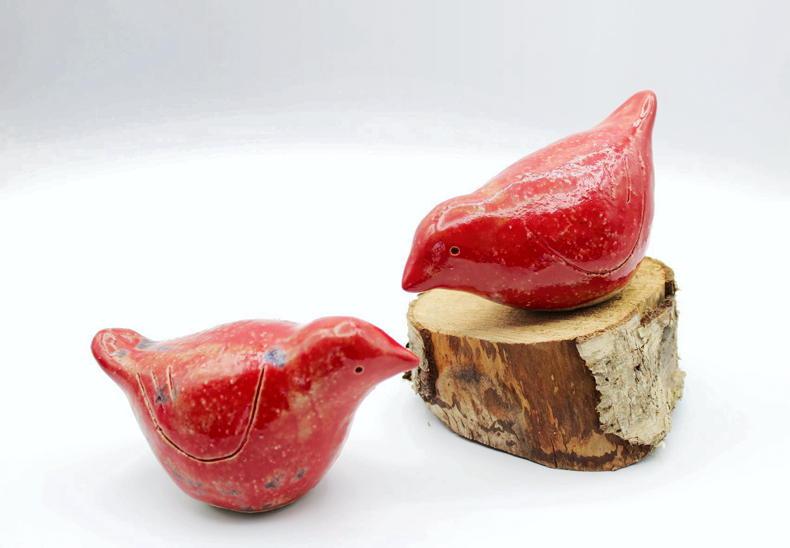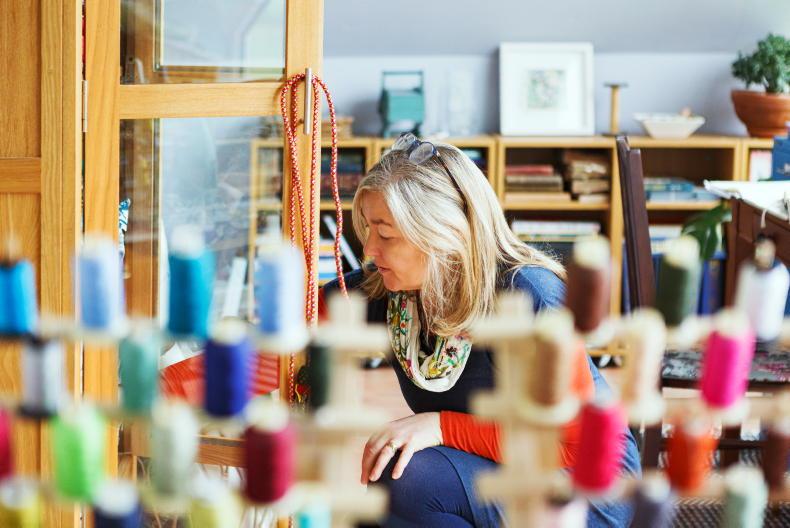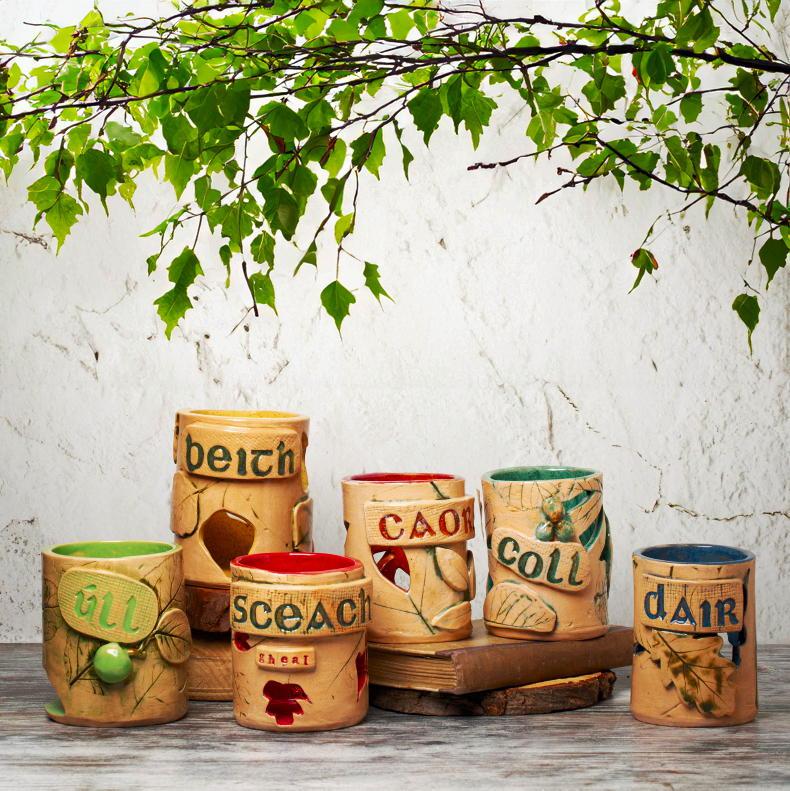How did you become an artist?
I always wanted to be an artist as far back as I can remember.
In sixth class at school, I discovered there was a college in Dublin where you could learn to be an artist not just for fun but as a career and I was thrilled.
My local secondary school had no art on the curriculum, so I made the decision, along with my parents, to travel to St Louis Secondary School in Carrickmacross, Co Monaghan, which had an excellent art department led by Sr Enda.
Five of our year group were accepted into the National College of Art and Design (NCAD) the year I applied, which was amazing.

Ceramic birds by Anita Reynolds.
I completed a degree in textile design and went on to do a higher diploma to become an art teacher. I spent 25 years teaching art in Beaufort College, Navan, and bringing up a young family, but I always knew that eventually I wanted to work as an artist full-time.
Around 2018, I began to job share in my teaching role, which allowed me the time to make and sell my own work.
It began with textile work I created with my students, which was noticed by staff and, in turn, friends and family sought commissions for retirements, birthdays, etc. This gave me the confidence to start creating again.

Anita Reynolds, Meet the Maker. \ Ana Dorada
The seeds of a plan to leave teaching had been sown. When COVID came, this was the push I needed and I made the decision to leave my full-time job to work on my own business.
I had and still have great support from the Design and Crafts Council of Ireland (DCCI) and the Local Enterprise Office (LEO) in Co Meath.
I’ve benefited from lots of courses and mentoring and I’ve applied for every grant available. For example, I completed a Get Set for Business course, which got me started on my journey.
Can you explain your creative process?
I usually start with a sketch. If it’s a commission, I will do some research before by taking photos and chatting to the client.
For my textile art pieces, I sketch on cotton and stretch the piece on a frame before adding colour using batik, which involves hot wax and dyes to build up layers of colour.
The fabric is then quilted and stitched using hand and machine embroidery. I often add beads and bring elements of the design out past the frame.

Ceramic hearts and Irish words. \ Ana Dorada
For my textile ranges, which I wholesale, I photograph and print my finished designs, allowing me to repeat the background which I complete by hand myself each time.
My clay work is also inspired by nature. I press the leaves from native Irish trees in my garden into the clay to create my Irish woodland lanterns.
I hand-build all my pieces myself using slab building and modelling techniques. I fire my garden pieces to stoneware temperature so they can withstand cold winter temperatures.
What inspires you?
My art is inspired by the natural world that surrounds me, as well as our historical heritage. I grew up in the countryside exploring the meadows and woodlands that surround my childhood home in Kilmainhamwood, Co Meath.

Ceramic lanterns by Anita Reynolds. \ Ana Dorada
My father trained in horticulture and passed on his love for trees. We planted a lot of trees around our home and I always knew the names and characteristics of each one.
I planted an apple pip at age 10, which is now a mature tree in my childhood garden. We were from a farming background and close to the land, bringing in the hay with my uncle, picking mushrooms and blackberries and swimming in a dammed-up stream during hot summers.
Growing up in Meath, I was surrounded by historical heritage and we visited local heritage sites as a family.
I’ve always loved ancient places that have a story to tell. The little church in Cruicetown, a few miles from my home, is only accessible across a farmer’s field and has always fascinated me. Its beautiful effigial tomb carved with an elegant couple in costume of the 1600s and surrounded by cupids and ornate carvings was my inspiration for my degree show in textiles.
I also spent two summers working as a guide at Knowth and Mellifont Abbey, inspiring a lifelong fascination with both sites. I am one of only a few people who has ever crawled into the main tomb at Knowth guided by Professor George Eoghan, who was still excavating the site when I worked there in 1992.

Blue tit by Anita Reynolds. \ Ana Dorada
Inside, we saw the huge stone basin carved so beautifully by an ancestor and artist thousands of years before me.
What are your best sellers?
My Words from the Heart is a range of small meaningful Irish words pressed into clay using a wooden printer’s type once used by my father and grandfather in their printing business in Kilmainhamwood.
Each ceramic heart comes in an eco-friendly box with a bilingual card partly funded by Foras na Gaeilge, which explains the story of the heart and the meaning of the word.
My four seasons framed textile art range is also among my bestselling pieces. The same woodland scene inspired by a photo taken in Mullaghmeen Woods, Co Meath, is shown with the changing colours and textures of the four seasons.
What is the role of sustainability in your art/business?
Sustainability is very important to me as an artist, who is inspired by our beautiful natural world. It’s crucial that I do nothing to damage the environment further.
I have taken part in the Green for Micro Scheme with Meath LEO, where my studio and business have been assessed. I’ve made improvements to both as a result of that scheme.
I have also planted trees to offset the carbon that I use and I plan to do this on an ongoing basis.
I reuse and recycle in my studio as much as possible. I create a range of batiks called Megalithic Marks which are inspired by the art of the Boyne Valley and created on damaged vintage Irish damask linens that were no longer useful.
I’m very interested in doing anything I can to highlight the horrors and waste involved in fast fashion.
I facilitate workshops in embroidery that teach how to prolong the life of garments such as jeans that are stained or damaged. Embroidery can be used to hide stains and enhance garments that are considered waste. This is something I hope to promote and work on further in the future.
If you’d like to see more of Anita’s work, visit her website here.
Read more
Meet the Maker: Majella O'Neill Collins
Meet the Maker: Orla Hickey
How did you become an artist?
I always wanted to be an artist as far back as I can remember.
In sixth class at school, I discovered there was a college in Dublin where you could learn to be an artist not just for fun but as a career and I was thrilled.
My local secondary school had no art on the curriculum, so I made the decision, along with my parents, to travel to St Louis Secondary School in Carrickmacross, Co Monaghan, which had an excellent art department led by Sr Enda.
Five of our year group were accepted into the National College of Art and Design (NCAD) the year I applied, which was amazing.

Ceramic birds by Anita Reynolds.
I completed a degree in textile design and went on to do a higher diploma to become an art teacher. I spent 25 years teaching art in Beaufort College, Navan, and bringing up a young family, but I always knew that eventually I wanted to work as an artist full-time.
Around 2018, I began to job share in my teaching role, which allowed me the time to make and sell my own work.
It began with textile work I created with my students, which was noticed by staff and, in turn, friends and family sought commissions for retirements, birthdays, etc. This gave me the confidence to start creating again.

Anita Reynolds, Meet the Maker. \ Ana Dorada
The seeds of a plan to leave teaching had been sown. When COVID came, this was the push I needed and I made the decision to leave my full-time job to work on my own business.
I had and still have great support from the Design and Crafts Council of Ireland (DCCI) and the Local Enterprise Office (LEO) in Co Meath.
I’ve benefited from lots of courses and mentoring and I’ve applied for every grant available. For example, I completed a Get Set for Business course, which got me started on my journey.
Can you explain your creative process?
I usually start with a sketch. If it’s a commission, I will do some research before by taking photos and chatting to the client.
For my textile art pieces, I sketch on cotton and stretch the piece on a frame before adding colour using batik, which involves hot wax and dyes to build up layers of colour.
The fabric is then quilted and stitched using hand and machine embroidery. I often add beads and bring elements of the design out past the frame.

Ceramic hearts and Irish words. \ Ana Dorada
For my textile ranges, which I wholesale, I photograph and print my finished designs, allowing me to repeat the background which I complete by hand myself each time.
My clay work is also inspired by nature. I press the leaves from native Irish trees in my garden into the clay to create my Irish woodland lanterns.
I hand-build all my pieces myself using slab building and modelling techniques. I fire my garden pieces to stoneware temperature so they can withstand cold winter temperatures.
What inspires you?
My art is inspired by the natural world that surrounds me, as well as our historical heritage. I grew up in the countryside exploring the meadows and woodlands that surround my childhood home in Kilmainhamwood, Co Meath.

Ceramic lanterns by Anita Reynolds. \ Ana Dorada
My father trained in horticulture and passed on his love for trees. We planted a lot of trees around our home and I always knew the names and characteristics of each one.
I planted an apple pip at age 10, which is now a mature tree in my childhood garden. We were from a farming background and close to the land, bringing in the hay with my uncle, picking mushrooms and blackberries and swimming in a dammed-up stream during hot summers.
Growing up in Meath, I was surrounded by historical heritage and we visited local heritage sites as a family.
I’ve always loved ancient places that have a story to tell. The little church in Cruicetown, a few miles from my home, is only accessible across a farmer’s field and has always fascinated me. Its beautiful effigial tomb carved with an elegant couple in costume of the 1600s and surrounded by cupids and ornate carvings was my inspiration for my degree show in textiles.
I also spent two summers working as a guide at Knowth and Mellifont Abbey, inspiring a lifelong fascination with both sites. I am one of only a few people who has ever crawled into the main tomb at Knowth guided by Professor George Eoghan, who was still excavating the site when I worked there in 1992.

Blue tit by Anita Reynolds. \ Ana Dorada
Inside, we saw the huge stone basin carved so beautifully by an ancestor and artist thousands of years before me.
What are your best sellers?
My Words from the Heart is a range of small meaningful Irish words pressed into clay using a wooden printer’s type once used by my father and grandfather in their printing business in Kilmainhamwood.
Each ceramic heart comes in an eco-friendly box with a bilingual card partly funded by Foras na Gaeilge, which explains the story of the heart and the meaning of the word.
My four seasons framed textile art range is also among my bestselling pieces. The same woodland scene inspired by a photo taken in Mullaghmeen Woods, Co Meath, is shown with the changing colours and textures of the four seasons.
What is the role of sustainability in your art/business?
Sustainability is very important to me as an artist, who is inspired by our beautiful natural world. It’s crucial that I do nothing to damage the environment further.
I have taken part in the Green for Micro Scheme with Meath LEO, where my studio and business have been assessed. I’ve made improvements to both as a result of that scheme.
I have also planted trees to offset the carbon that I use and I plan to do this on an ongoing basis.
I reuse and recycle in my studio as much as possible. I create a range of batiks called Megalithic Marks which are inspired by the art of the Boyne Valley and created on damaged vintage Irish damask linens that were no longer useful.
I’m very interested in doing anything I can to highlight the horrors and waste involved in fast fashion.
I facilitate workshops in embroidery that teach how to prolong the life of garments such as jeans that are stained or damaged. Embroidery can be used to hide stains and enhance garments that are considered waste. This is something I hope to promote and work on further in the future.
If you’d like to see more of Anita’s work, visit her website here.
Read more
Meet the Maker: Majella O'Neill Collins
Meet the Maker: Orla Hickey











 This is a subscriber-only article
This is a subscriber-only article










SHARING OPTIONS: